These Sample papers are part of CBSE Sample Papers for Class 10 Science. Here we have given CBSE Sample Papers for Class 10 Science Paper 2
CBSE Sample Papers for Class 10 Science Paper 2
| Board | CBSE |
| Class | X |
| Subject | Science |
| Sample Paper Set | Paper 2 |
| Category | CBSE Sample Papers |
Students who are going to appear for CBSE Class 10 Examinations are advised to practice the CBSE sample papers given here which is designed as per the latest Syllabus and marking scheme as prescribed by the CBSE is given here. Paper 2 of Solved CBSE Sample Paper for Class 10 Science is given below with free pdf download solutions.
Time : 3hrs
Maximum Marks : 80
General Instructions
- The question paper comprises two sections, A and B. You are to attempt both the sections.
- All questions are compulsory.
- All questions of Section A and B are to be attempted separately.
- There is an internal choice in two questions of three marks each and one question of five marks.
- Question numbers 1 and 2 in Section A are one mark questions. They are to be answered in one word or in one sentence.
- Question numbers 3 to 5 in Section A are two marks questions. These are to be answered in 30 words each.
- Question numbers 6 to 15 in Section A are three marks questions. These are to be answered in about 50 words each.
- Question numbers 16 to 21 in Section A are 5 marks questions. These are to be answered in 70 words each.
- Question numbers 22 to 27 in Section B are based on practical skills. Each question is a two marks question. These are to be answered in brief.
SECTION A
Question 1.
How is ozone formed in nature ? (1)
Question 2.
Name the oxidising and reducing agents in the following . (1)
2H2S + SO2 → 2H2O + 3S
Question 3.
An element ‘X’ has atomic number 15; (2)
(a) Write its electronic configuration
(b) State the group to which ‘X’ belongs
(c) Is ‘X’ a metal or a non-metal
(d) Write the formula of it’s oxide.
Question 4.
Which mirror can give an image of magnification -1 ? Where is the object placed to give this image? (2)
Question 5.
Write a balanced chemical equation, when: (2)
(i) Ferrous sulphate crystals are heated strongly
(ii) Barium chloride aqueous solution is mixed with sodium sulphate.
Question 6.
(a) Mineral riches of the earth’s crust are either extracted or used. For every ton of metal, a large amount of slag is discarded which damages the environment. What kind of management is needed in this regard ? (3)
(b) Why do you think there should be equitable distribution of resources? What forces would be working against an equitable distribution of resources?
Question 7.
In one of the industrial process used for manufacture of sodium hydroxide, a gas ‘X’ is formed as a by product. The gas ‘X’ reacts with lime water to give a compound ‘Y5 which is used as a bleaching agent in chemical industry. Identify ‘X’ and ‘Y’ giving chemical equation of the reactions involved. (3)
Question 8.
(a) How is walking different from reflex action ? (3)
(b) Kiran’s father was feeling thirsty most of the time. He was feeling tired and had excess of urination. Kiran took him to a doctor. Doctor advised him to take artificial sweetener instead of sugar and go for regular walks.
- Which disease is Kiran’s father suffering from?
- State the cause of the disease.
Question 9.
(a) Define focus of convex lens.
(b) Give two differences between real and virtual images. (1+2)
Question 10.
(a) State the principle of working of a generator.
(b) What would be the direction of induced current if the magnetic field is east to west and the conductor moves in it from north to south?
(c) Suggest any one step that can be taken in a generator to increase the
strength of the induced current. (1+1+1)
OR
(a) Give the energy conversion in an electric motor.
(b) Draw a diagram of electric motor showing the direction of magnetic field, current and force. (1+2)
Question 11.
(a) To which wire is fuse connected and how is it connected? Give reason for your answer.
(b) A device of 2.2 kW power is operated on a voltage supply of 220 V in a circuit that has a fuse rating of 5 A. What result do you expect ? Explain. (1\(\frac { 1 }{ 2 } \) + 1\(\frac { 1 }{ 2 } \))
Question 12.
Describe in brief the changes that uterus undergoes (3)
(i) To receive the zygote
(ii) If zygote is not formed
Question 13.
(a) With respect to elements of 3rd period; name the following : (3)
- Element with smallest size
- Most reactive metal
- A Metalloid
- Most electronegative element
(b) Atomic size increases down the group of periodic table. Explain
Question 14.
(a) Why is vegetative propagation practised for growing some types of plants? (3)
(b) How is binary fission different from multiple fission?
Question 15.
Ram got a biogas plant installed in his backyard. He feeds it with all the household biodegradable waste. The gas produced is used by him for cooking food.
(a) Give the main component of the gas produced in the biogas plant.
(b) Why is it considered to be an efficient fuel, give any two reasons.
(c) What values are shown by Ram? (1+1+1)
Question 16.
(a) What happen when : (write equations)
- Ethanol reacts with sodium metal.
- Methane reacts with chlorine in diffused sunlight.
- Ethanol reacts with methanoic acid.
(b) Write a chemical test (equation) to distinguish
- Ethanol and ethanoic acid
- Ethene and ethane. (5)
Question 17.
(a) Explain electrolytic refining of copper with a labelled diagram and the reactions taking place at the cathode and anode. (5)
(b) Write a chemical equation to illustrate the use of aluminium for joining cracked railway lines.
(c) Write the composition of:
(i) Brass
(ii) Solder.
Question 18.
(a) Draw a neat diagram of Human Alimentary Canal and label the following parts: (5)
- Structure that stores extra bile juice
- Site for complete digestion
(b) State the significance of HCl released in stomach in digestion.
(c) What is Lymph? State functions of Lymph.
OR
(a) Draw a neat labelled diagram of cross section of a leaf.
(b) How does translocation of food occur in plants ?
Question 19.
(a) How is the sex of the child determined in human beings? (5)
(b) What are fossils? How can the age of fossils be determined?
Question 20.
(a) Define dispersion of light.
(b) Explain the cause of dispersion of light.
(c) In the spectrum of sunlight, which colour is at the top? Give reason for your answer.
(d) How can you see a rainbow on a sunny day? What should be the position of sun with respect to the ob server? (1+1+1\(\frac { 1 }{ 2 } \)+1\(\frac { 1 }{ 2 } \))
Question 21.
(a) What would he the reading of voltmeter and ammeter in the following circuit ?

(b) What would be the total power in the circuit?
(c) How will the reading of ammeter and voltmeter be affected if one more device of 22W power is added in parallel to the above circuit? (3+1+1)
SECTION B
Question 22.
(a) State Ohm’s law
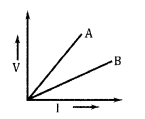
(b) Which of the two graphs, A or B, corresponds to higher resistance ? (1+1)
Question 23.
Show angle of deviation in a diagram of refraction of light through a glass prism. (2)
Question 24.
Name two salts each of calcium and magnesium which make the water hard. (2)
Question 25.
Write two physical properties of acetic acid. (2)
Question 26.
In the following sketch of the stomatal apparatus label the parts I, II, III and IV. (2)
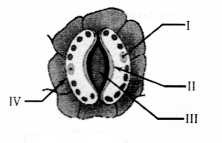
Question 27.
Name and define the process of asexual reproduction shown by yeast. (2)
ANSWERS
SECTION A
Answer 1.
O2 \(\underrightarrow { uv } \) O + O (1/2 + 1/2)
O + O2 → O3
Answer 2.
Oxidising agent → SO2 (1)
Reducing agent → H2S
Answer 3.
(a) 2,8,5
(B) Group No. 15
(c) Non – metal
(d) X2O5
Answer 4.
Concave mirror
Object is placed at centre of curvature
Answer 5.

Answer 6.
(a) It is important that slag is disposed of safely. It can be used in industries like glass, cement etc.
(1/2 + 1/2)
(b) Equitable distribution of resources is important so that not just a handful of rich and powerful people benefit from these resources. Every citizen has equal rights to use these resources. (1/2 + 1/2)
Forces working against it
- Corruption
- Poverty
- Illiteracy and unawareness
- Unequal topographical distribution of the resources
Answer 7.

Answer 8.
(a)
| Walking | Reflex Action |
| It is voluntary | It is in voluntary |
| Controlled by cerebellum | Controlled by spinal cord |
(b) (i) Diabetes (1/2)
(ii) Lack/deficiency of hormone insulin (1/2)
Answer 9.
(a) Focus of convexlens is a point on the principal axis through which all the refracted rays pass when the incident rays are parallel to the principal axis. (1 + 2)
| Real Image | Virtual Image |
| Formed at a point where the rays actually meet after reflection or refraction | Formed at a point where the rays appear to meet after reflection or refraction |
| Inverted | Erect |
| Can be taken on a screen | Cannot be taken on a screen |
Answer 10.
(a) Electromagnetic Induction is the principle which states that if a conductor is moved in a magnetic field cutting the lines of force, then current is induced in the wire. (1)
(b) Vertically downwards (1)
(c) (i) Magnetic field can be stronger (1)
(ii) Wire can move with more speed
(iii) Greater length of wire can move in the magnetic field (anyone)
10. (a) Electrical to mechanical

Answer 11.
(a)
- Live wire
- In series to live wire
- So that when fuse melts the incoming of current should stop
(b) The device will not be able to work as fuse will melt.
I = \(\frac { P }{ V } =\frac { 2200W }{ 220V } \) = 10 A
So current exceeds the fuse limit.
Answer 12.
To receive the zygote
(i) The lining of the uterus thickens and gets richly supplied with blood to nourish the growing embryo
(1/2 + 1/2)
A disc shaped structure placenta develops in the uterine wall for nourishing embryo (1/2)
(ii) If zygote is not formed
Unfertilized egg remains for a day, uterine lining slowly breaks and comes out through the vagina and as blood and mucous (1/2 + 1/2 + 1/2)
Answer 13.
(a)
- Chlorine (Cl) (2)
- Sodium (Na)
- Silicon (Si)
- Chlorine (Cl)
(b) Down the group, number of shell increases, shielding factors increases, so the effective nuclear charge on the valence electron decreases and the size increases down the group. (1)
Answer 14.
(a) Vegetative propagation has the following advantages
- plants grown by vegetative propagation can bear flowers and fruits earlier that those produced from seeds
- plants which have lost the capacity of producing seeds can be grown by vegetative propagation
- All plants produced are genetically similar to the parent plant
- faster rate of multiplication and disease free varieties can be produced. (any two points) (1/2 + 1/2)
| Binary fission | Multiple fission |
| Parent cell splits into two daughter cells | Parent cell produces more than two daughter cells |
| No cyst is formed | Cyst is formed |
| Takes place in favourable conditions | Occurs in unfavourable conditions |
Answer 15.
(a) Methane (1)
(b) High calorific value, no residue (1/2+ 1/2)
(c) Responsibility, care
Answer 16.

(ii) Br, Water Test (1)
ethene decolourizes reddish brown colour of bromine water.
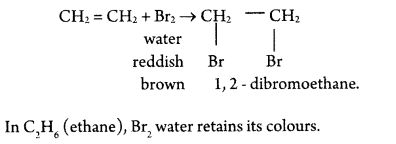
Answer 17.
(a) Cathode → Pure Cu rod
Anode → Impure Cu rod
Electrolyte → aq. CuSO4 (1 + 1)

At cathode:
Cu2+ + 2e– → Cu
At anode:
Cu – 2e → Cu2+
As reaction proceeds, thickness of pure rod (cathode) increases and impure copper rod thickness decreases. (1)
The impurities of Au, Ag falls down below anode and collect as anode mud.
![]()
(c) (i) Brass → Cu + Zn
(ii) Solder → Pb + Sn
Answer 18.
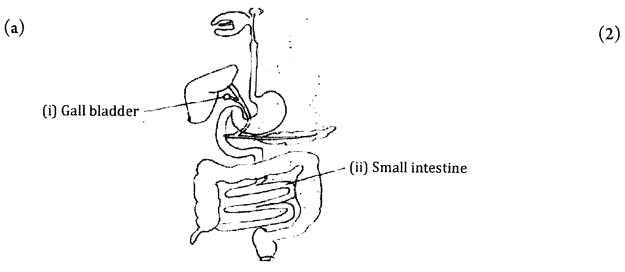
• Student must write (i) & (ii) along with labelling
(b) Significance of HCl
• Creates acidic medium which facilitates action of pepsin (1/2)
• Prevents growth of harmful microbes in food (1/2)
(c) Lymph – Tissue fluid in intercellular spaces, consisting of some plasma, proteins & blood cells
(1/2 + 1/2)
Functions –
• Carries digested and absorbed fat from intestine (1/2)
• Drains excess fluid from extra cellular spaces back into the blood (1/2)
OR

(b) Translocation of food in phloem
• Sucrose is transferred into phloem tissue using energy from ATP (1/2)
• This increases the osmotic pressure of the tissue causing water to move into it. (1/2)
• This pressure moves the material in the phloem to tissues which have less pressure. (1/2)
• This allows the phloem to move material according to the plant’s needs (1/2)
Answer 19.

OR
If explained the cross.
(b) Fossils – preserved traces of living organisms are called fossils (1)
Age of fossils
• Relative method – fossils closer to the surface are more recent than fossils which are in deeper layers (1/2)
• By detecting the ratios of different isotopes of the same element in fossil (1/2)
Answer 20.
(a) Dispersion of light is the splitting of light into its constituent colours. (1)
(b) Colours travel with different speeds in glass and so bend by different amount and separate out. (1)
(c) Red (1/2)
As red has maximum speed in glass, so refractive index of glass is minimum for red, making it bend the least. (1)
(d) If we look through a water fall or a fountain. (1)
The sun should be behind the observer. (1/2)
Answer 21.
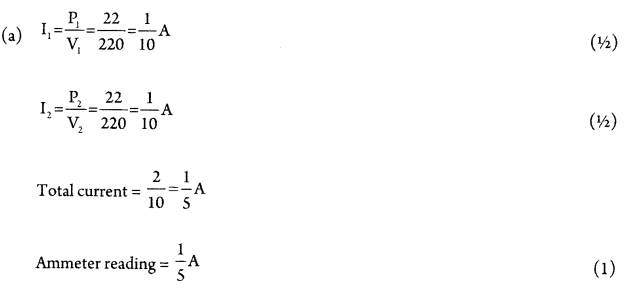
Voltmeter reading = 220 V
(b) Total power = p1 + p2 = 22 + 22 = 44 W
or P = IV = \(\frac { 1 }{ 5 } \) × 220 = 44 W
(c) Reading of ammeter will increase.
Reading of voltmeter will remain same.
SECTION B
Answer 22.
(a) Ohm’s law states that the current flowing through a conductor is directly pro to the potential difference across it, provided temperature remains constant. (1)
(b) A corresponds to higher resistance. (1)
Answer 23.

Answer 24.
(i) Ca(HCO3)2
MgSO4
CaCl2
MgCl2
Answer 25.
(i) Colourless liquid, soluble in water in all proportions.
(ii) Changes blue litmus red.
(iii) Freezes during winters as temperature falls below 17°C.
Answer 26.
I – Chloroplast
II – Nucleus
III – Stoma or Stomatal pore
IV – Guard cell
Answer 27.
Budding (1)
An outgrowth called bud arises from the yeast cell which later grows into a new yeast cell. (1/2 + 1/2)
We hope the CBSE Sample Papers for Class 10 Science Paper 2 help you. If you have any query regarding CBSE Sample Papers for Class 10 Science Paper 2, drop a comment below and we will get back to you at the earliest.